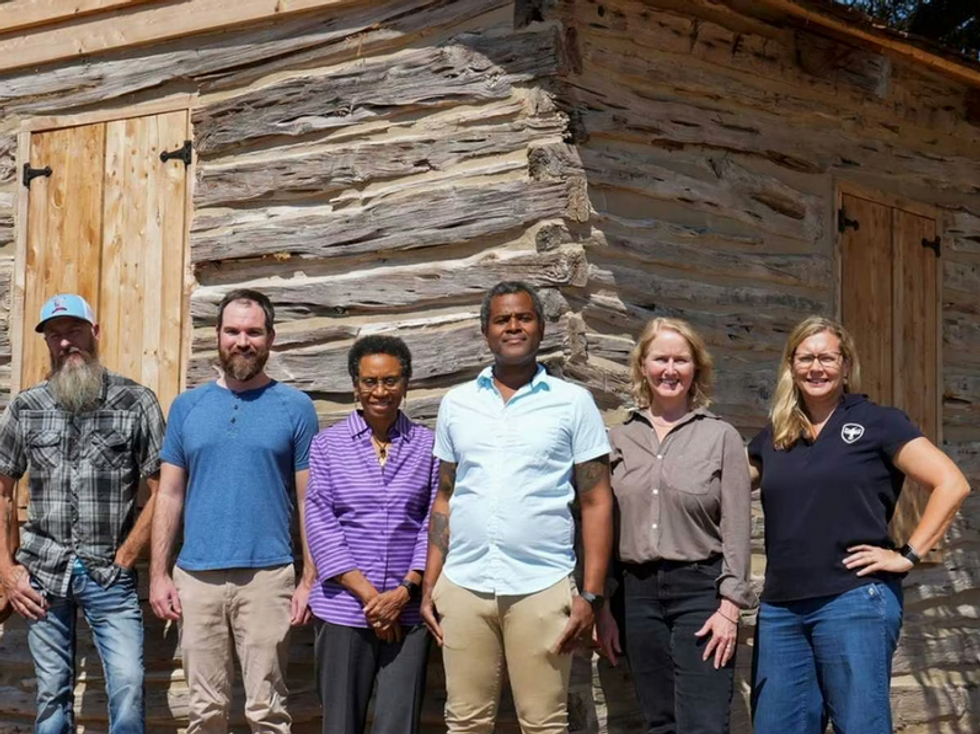Read Local
What to read right now: Elizabeth Crook on her new novel and books every Texan should read
On a Tuesday evening in late May, at the kickoff event for the 2014 Mayor’s Book Club, Austin novelist Elizabeth Crook, said very sweetly in her slight Texas-twang, “I wasn’t planning to write another violent story.”
The petite blonde, who on this night is dressed in a cream-colored ruffled Maxi ruffled dress with boots peeking out and a red cardigan on her shoulders, may not fit the picture of someone who writes violent crime scenes. And yet her latest novel, Monday Monday — this year's Mayor’s Book Club selection — begins with exactly that: a fictionalized account of the bloody, infamous scene at The University of Texas at Austin on August 1, 1966, the day of the UT Tower shootings.
The novel builds quickly and richly from there, following the lives of three characters whose lives become forever entwined on that day. Crook paints strong and appealing characters just as vividly as she describes the Texas landscapes that they travel through. Monday, Monday is immediately gripping and wholly compelling — and it’s fiction at its finest. Crook takes a real event and zooms in, creating an imaginative space to explore the hard questions tragedies like the UT tower shootings beg: what are the less obvious wounds a tragedy inflicts on those involved? How does it alter the course of their lives? How do we move forward in the face of tragedy, or are we forever bound by it?
Recently, CultureMap caught up with Crook to chat about her writing process, old versus new Austin, and what it is that’s so compelling about reading — and writing — violent stories. Plus, we scored some serious reading recommendations, including the authors who inspire her most, why classically creepy children's stories are better, books she thinks every Texan should read, and what titles are on her nightstand this summer (and should probably be on yours, too).
CultureMap: Originally, Monday, Monday was a story about a mother and her two daughters and there was no violence or bloodshed. It wasn’t until you read Pamela Colloff’s oral history piece in Texas Monthly that the UT shooting even became a part of the story, let alone the driving force behind it. You told the audience at the kickoff event that there “is a richness to writing without an outline... It’s like driving in a fog. Characters go places you wouldn’t have thought to send them.” Why do you think you keep sending your characters into violent situations?
Crook: If there’s nothing serious at stake for the characters, then there’s nothing to worry about on their behalf and no real reason to care about them deeply. To me, a story is more urgent and relevant when the stakes are high. It’s easier to write because you know what it’s about — it’s not esoteric, but about something real that happened. In this case, it’s about something real that happened closer to home than the other stories I’ve written.
CultureMap: I was struck at your reading by what you said about writing the first 30 pages of the book. In those first pages, you paint the immediate scene during and after the shootings, and how the reactions that day were so raw, partly because there was no precedent for an event like this. Today, unfortunately, there are far too many precedents for school shootings. I would venture to say that in today's world, Shelly and others would have probably realized what was happening much more quickly. In what other ways would this have been a different book if it was based off of a more current act of violence?
Crook: This was the first of these horrendous school shootings and people were slow to believe it was actually happening. Other than that, the reactions were similar to what we see today. People took care of each other. A lot of students risked their lives to help others. A lot of students didn’t and felt the need to atone or explain in some way. Society as a whole responded with the same media obsession and with all the unanswerable questions of why? What, exactly, went so horribly wrong? I think the main difference is that the 1966 incident was an isolated event that happened without warning. Today we’ve had plenty of warning. We know there’s another coming. We need better, more accessible mental health care, and we need reasonable gun laws. We’re not naïve any more.
CultureMap: It's easy to have a heavy-hand when writing about catastrophic events, and you manage to write dramatically in a very skilled and balanced way. There’s tension and high stakes in Monday, Monday without any sensationalism or over-the-top sentimentality. What books or authors have you read that helped you develop this skill? Did you read a lot of violent stories growing up?
Crook: I was fortunate that my mother read a lot of substantive books to my brother and sister and me when we were growing up. Some were amusing books, but others were stories that made us aware of the fact that not every child had a life as safe as ours. My mom’s reading time with us at night went on for hours and lasted for years, even after we were old enough to read for ourselves.
She read the story of The Little Match Girl [by Hans Christian Anderson] who was beaten by her father and who froze to death selling matches, and a novel called The Faraway Lurs [by Harry Behn] about a girl who became a human sacrifice to the gods. I’ve just read this one aloud with my twelve year old daughter. We went through all the Tolkien books [here's a rad 50th anniversary, leather-bound, one-volume edition of Lord of the Rings, by the way] and almost everything for children by C. S Lewis — the tortured death of Aslan on the Stone Table in The Chronicles of Narnia was especially horrifying. And the shooting of Old Yeller in the novel by Fred Gipson. There was a poem about a rabbit caught in a snare and a child trying frantically to locate where his cries were coming from so she could set him free.
The message in these stories was pretty clear: terrible things could happen. And what would we feel if they happened to us? That was the thing to think about. There are a lot of creepy books for children now, and I’m not sure these represent the same kind of reading. Real-life tragedy is one thing [because] we can learn from it. Creepiness seems different to me.
CultureMap: As someone fairly new to Austin, one of the great things about reading Monday, Monday was being transported into this rich visual of Austin, and really, Texas in general, in the late 1960s through early 2000s. What sort of research did you do to recreate this world?
Crook: This was the first book I’ve written that didn’t require years of research. I grew up just down the road in San Marcos, so I already knew the places I was writing about. I knew the landscape, the weather, the kind of people my characters were. And I have a lot of friends who were students at UT in the sixties, and quite a few who were there on campus the day of the shootings. Most of the research just involved talking to people and asking the right questions.
CultureMap: In the course of the research, did you find yourself nostalgic for "the old Austin"?
Crook: I didn’t move to Austin until the eighties, so I missed the sixties here. I guess I shouldn’t lament the passing of a time I didn’t get to experience in Austin, but somehow I do feel nostalgic about it, especially after seeing it through the eyes of my characters. Imagine no traffic, no sprawl, darker nights.
CultureMap: What are some examples of great Texas writing? What should be required reading for any Austinite, or any Texan?
Crook: I would recommend a visit to The Wittliff Collections at Texas State in San Marcos for anyone who wants to know more about great Texas writers. As for Texas books I’ve personally loved:
- Goodbye to a River by John Graves is stunningly beautiful. Many of us here in Austin knew and loved John Graves.
- Lonesome Dove by Larry McMurtry is another personal favorite and has the best opening lines, ever: “When Augustus came out on the porch the blue pigs were eating a rattlesnake—not a very big one…”
- I also love the Texas books my friend Stephen Harrigan has written: Remember Ben Clayton and The Gates of the Alamo are at the top of the list. Also, his new book of Texas essays: The Eye of the Mammoth.
- For kids: Fred Gipson’s books Old Yeller and Savage Sam can still make me cry, and the Hank the Cowdog series by John Erickson is extremely entertaining even for adults.
- I would also recommend The Captured: a True Story of Abduction by Indians on the Texas Frontier by Scott Zesch. There are a number of excellent journals from the early days by both men and women, but too many to list, and there are a lot of remarkable books published in the last five years that I haven’t gotten around to reading yet.
CultureMap: And how about current books you are reading or looking forward to? What’s on your summer reading list?
Crook: As for my current reading, I have a huge stack of history books I need to get through for research on a story I’m thinking about writing next. So I don’t read much for pleasure. The last book I was smitten with was The Antidote: Happiness for People Who Can’t Stand Positive Thinking, by Oliver Burkeman — lots of wisdom and humor in that book. The most recent novel I loved was The Sense of an Ending by Julian Barnes. I've just started John le Carre's A Delicate Truth and it's already swept me away. And I’m looking forward to reading fellow Austinite Sarah Bird’s new book, Above the East China Sea.
The Mayor’s Book Club kick-off event on May 27th, which was held at the Bob Bullock museum and included an introduction by Mayor Leffingwell himself, was just the beginning of yearlong local appearances by the author and an ongoing discussion of the novel. The next upcoming event takes place on Saturday, August, 16th, when Crook will lead an adult writing workshop at the Terrazas Branch Library. For a full listing of upcoming Mayor’s Book Club events featuring Monday, Monday and Elizabeth Crook, go here.

 The Neill-Cochran House Museum's mid-19th-century slave quarters received Planning and Historic Designation grant support for restoration and historical interpretation.Photo courtesy of Preservation Austin
The Neill-Cochran House Museum's mid-19th-century slave quarters received Planning and Historic Designation grant support for restoration and historical interpretation.Photo courtesy of Preservation Austin Built around 1863, the Henry G. Madison cabin in Rosewood Park received Bricks and Mortar grant support for preservation planning work.Photo courtesy of Preservation Austin
Built around 1863, the Henry G. Madison cabin in Rosewood Park received Bricks and Mortar grant support for preservation planning work.Photo courtesy of Preservation Austin